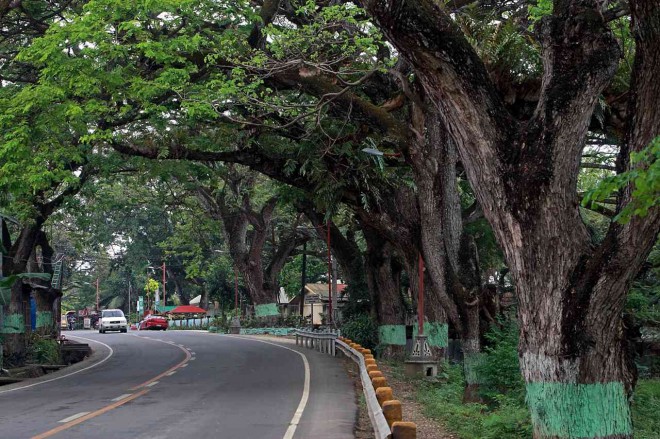A century-old reason for 100-year-old trees

BACK in the days when roads were for people, trees served a purpose in Carcar City and other areas in southern Cebu province: To provide shade for hundreds of residents who got to their destinations on foot. TONEE DESPOJO/CEBU DAILY NEWS
Anyone traveling to southern Cebu province will never miss passing under humongous acacia trees on both sides of the two-lane national highway in Barangay Perrelos, Carcar City.
The magnificent canopy of trees and their ageless beauty have been the subject of social media commentary, as well as travel photography.
With more and more arboreal tunnels disappearing all over the country, those in Perrelos and the other acacia trees standing on both sides of the highway in Naga City and San Fernando town—both contiguous to Carcar—have been the subject of a campaign to save them from destruction.
Last year, the two-lane highway hugged by the trees underwent widening with funding from the Department of Public Works and Highways. The project is, in fact, nearing the green tunnel in Perrelos.
Just who planted these trees and why have they survived up to the present while others have not?
Article continues after this advertisementExplanation
Article continues after this advertisementThere are two possible claimants to fame.
One is Claude Russell, the Bureau of Public Works (BPW) district engineer of Cebu in 1915. The other is Capt. Valeriano Segura, a war hero who died in the Bataan Death March and whose body was never found by his next of kin.
In the 1915 issue of the BPW Quarterly Bulletin (Vol. 3 No. 4), Russell reported the planting of acacia trees along 58 kilometers of first-class roads in Cebu. However, he did not identify their locations.
Russell said: “Some 98 kilometers of road have been planted with various kinds of trees, 39 kilometers being planted in coconuts, 58 kilometers in acacia, and 1 kilometer with lumbang. This work will be continued until all the first-class and a large part of the second-class roads are planted.”
Foot traffic
He thankfully provided us with the reason why these trees were planted. “It has been noticed that the problem of shoulder maintenance is almost completely solved when the road is properly shaded.”
Apparently, due to Cebu’s already large population even at that time, coupled with the relative scarcity of work animals and carts, foot traffic on the entire island was deemed the heaviest among all the provinces in the Philippines.
In certain Cebu towns, Russell reported that as many as 1,000 people use the road every hour.
Captain Segura is best known in Cebu as one of the heroes of World War II and the father of one of the most unforgettable figures of the Cebu guerrilla movement, the late Col. Manuel Segura.
As the story goes, Valeriano had tried to enter West Point to start a military career but failed to meet the height requirement. Instead, he entered Purdue University and completed a civil engineering degree, which he soon put to good use back in the Philippines as a district engineer.
According to the Segura family, Valeriano headed the BPW districts in the Visayas and Mindanao and was the one who ordered the planting of the trees to help provide shade to the newly opened roads that linked town after town sometime during the first two decades of the American colonial period.
War hero
In the 1915 BPW Quarterly Bulletin, he was mentioned as the district engineer of San Jose town, Antique province.
One of his grandchildren, the columnist and his namesake Valeriano “Bobbit” Segura Avila, has cited in his writings the late Captain Segura’s prominent role in the planting of acacia trees.
As to why the particular fondness for these huge, shady and leafy acacias, former Cebu Provincial Board Member Roberto “Babbit” Ybañez, who married into the Segura family, said acacia was chosen most probably because Captain Segura was a Mason and was merely inspired by the Masonic belief that the Jewish patriarch Abraham was buried under the shade of a rain tree or to be more precise, an acacia tree.
To be fair, the national highway traversing the northern and southern parts of Cebu are dotted with occasional acacia trees. But it is only in San Fernando and Carcar that the unrivaled concentration of trees has evolved into a magnificent vista.
The reason the trees survived in large clusters down south and not up north of Cebu City may have something to do with World War II. Roads, bridges and transportation routes were easy targets for annihilation as the Liberation of Cebu progressed starting in late March 1945.
The Japanese high command had ordered a hasty retreat to northern Cebu following the landing of US forces in Talisay City on March 26, 1945. This fateful decision to move north spared southern Cebu from the carnage that swept northern Cebu, from Mandaue City to the towns of Daanbantayan and Medellin.
This also helps explain why very few turn-of-the-century ancestral houses, as well as late Spanish-era stone churches, are found in northern Cebu as compared to the south.
(Editor’s Note: Jobers Reynes Bersales teaches heritage courses at the University of San Carlos (USC) and is the research and exhibitions curator of USC Museum. He has authored or coauthored a number of heritage coffee table books.)